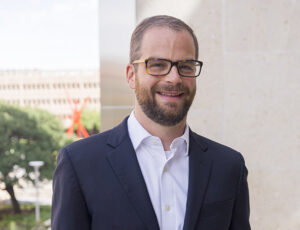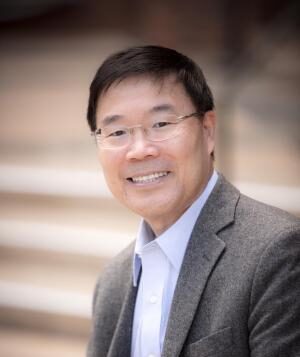
Investigators

Seth Bank (PI)
Cullen Trust Professor, UT-Austin
Seth R. Bank holds a Cullen Trust Endowed Professorship of Electrical and Computer Engineering at the University of Texas at Austin. He received the M.S. and Ph.D. degrees from Stanford University and the B.S. from the University of Illinois. His research centers around the growth and application of novel heterostructures and nanocomposites to electronic/photonic devices. He has coauthored over 400 papers and presentations, is an IEEE Fellow, and has received a PECASE, NSF CAREER, AFOSR YIP, ONR YIP, DARPA YFA, Young Scientist Award from ISCS, Young Investigator Award from NAMBE, and his students have received several best paper awards.

Andrea Alù (Co-PI)
Einstein Professor, CUNY
Andrea Alù is the founding director of the Photonics Initiative at the CUNY Advanced Science Research Center, Einstein Professor of Physics at the CUNY Graduate Center, and Professor of Electrical Engineering at The City College of New York. He is affiliated with the Wireless Networking and Communications Group and the Applied Research Laboratories, both based at the University of Texas at Austin, where he is a Senior Research Scientist and Adjunct Professor. His research interests span over a broad range of technical areas, including applied electromagnetics, nano-optics and nanophotonics, microwave, THz, infrared, optical and acoustic metamaterials and metasurfaces, plasmonics, nonlinearities and nonreciprocity, cloaking and scattering, acoustics, optical nanocircuits and nanoantennas.

Federico Capasso (Co-PI)
Wallace Professor, Harvard
Federico Capasso is the Robert Wallace Professor of Applied Physics at Harvard University, which he joined in 2003 after a 27-years career at Bell Labs from postdoc to Physical Research VP. He pioneered bandgap engineering of heterostructure materials and devices, including the quantum cascade laser, metasurface based flat optics, MEMS based on the Casimir effect and measured for the first time the repulsive Casimir force. He is a member of NAS, NAE and the American Academy of Arts and Sciences (AAAS). His awards include the Balzan Prize for Applied Photonics, the King Faisal Prize, the APS Arthur Schawlow Prize, the AAAS Rumford Prize, the IEEE Edison Medal, OSA’s R. W. Wood Prize, the Materials Research Society Medal, and the Witherill medal of the Franklin Institute. In 2021, he received the Fredric Ives Medal/Jarus W. Quinn Prize.

Alex Demkov (Co-PI)
Einstein Professor, CUNY
Alex Demkov is a professor of Physics at The University of Texas at Austin. He received his Ph.D. in theoretical physics in 1995 from Arizona State University (ASU). In 1995-1997, he was a postdoctoral researcher at ASU. In 1997-2005, he was a principal staff scientist in Motorola.s R&D organization providing theoretical support for the development of low- and high-k dielectric materials. In 2005, he joined the faculty of the Physics Department at the University of Texas at Austin. Prof. Demkov has published over 100 research papers and has been awarded seven U.S. patents. He has contributed to several books and edited one, as well asco-authored the 2005 edition of the International Technology Roadmap for Semiconductors (ITRS). Demkov received the NSF CAREER award, 2011 IBM Faculty Award, and is a Fellow of the American Physical Society.

Xiaoqing Pan (Co-PI)
Einstein Professor, CUNY
Xiaoqing Pan is an internationally recognized materials scientist and electron microscopy expert due to his pioneering development and applications of novel transmission electron microscopy (TEM) methods for probing the atomic scale structure, properties and dynamic behaviors of materials. His work has led to the discoveries of new materials and novel functionalities. Pan has received the National Science Foundation’s CAREER Award and the Chinese NSF’s Outstanding Young Investigator Award. He is an elected fellow of the American Ceramic Society, American Physical Society, Microscopy Society of America, and the Materials Research Society. He has published over 400 peer-reviewed scientific papers in high impact journals such as Nature, Science, and Nature Materials and has a high citation rate. Pan is currently the Henry Samueli Endowed Chair in Engineering, professor of materials science and engineering, and professor of physics and astronomy. In addition, he is the inaugural director of the Irvine Materials Research Institute (IMRI), and founding director of the Center for Complex Active Materials (CCAM – an NSF MRSEC). Previously, he was a professor and the Richard F. and Eleanor A. Towner Endowed Chair of Engineering and director of the Electron Microbeam Analysis Laboratory at the University of Michigan.

Collaborators

Colaborator Name
Colaborator Title
Ut eu auctor nulla. Pellentesque fermentum vitae ante in iaculis. Integer bibendum cursus eleifend. Vivamus lacinia, risus ac porttitor ornare, risus nisi porta tortor, ut sagittis erat nibh sed mauris.

Colaborator Name
Colaborator Title
Ut eu auctor nulla. Pellentesque fermentum vitae ante in iaculis. Integer bibendum cursus eleifend. Vivamus lacinia, risus ac porttitor ornare, risus nisi porta tortor, ut sagittis erat nibh sed mauris.

Colaborator Name
Colaborator Title
Ut eu auctor nulla. Pellentesque fermentum vitae ante in iaculis. Integer bibendum cursus eleifend. Vivamus lacinia, risus ac porttitor ornare, risus nisi porta tortor, ut sagittis erat nibh sed mauris.

